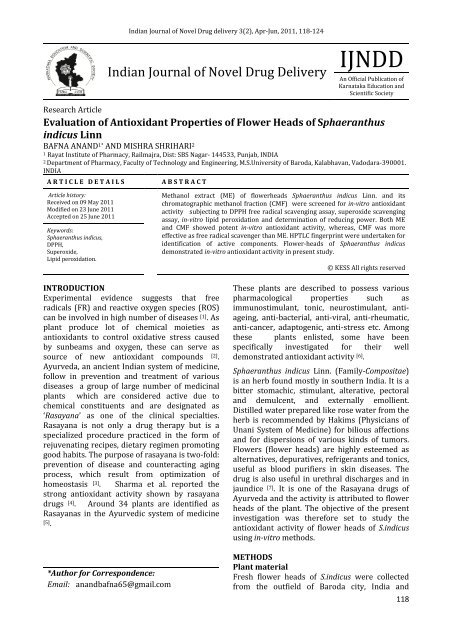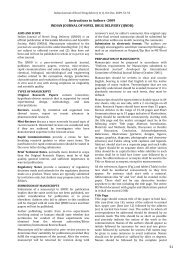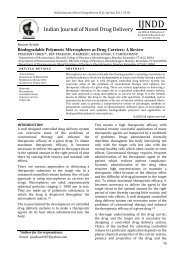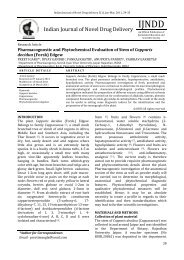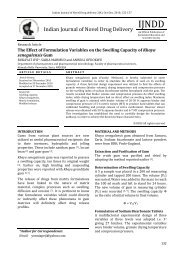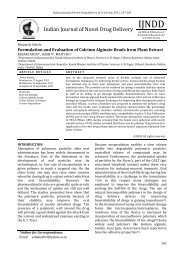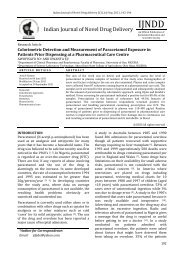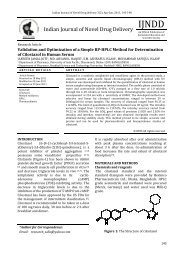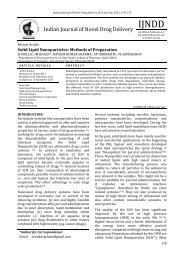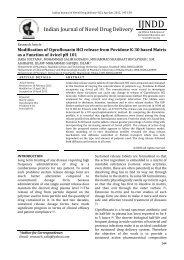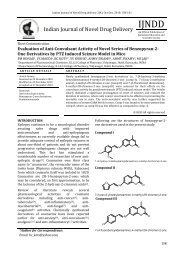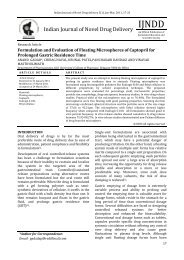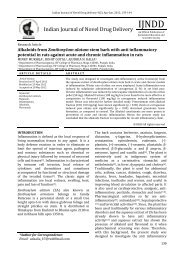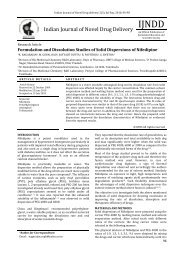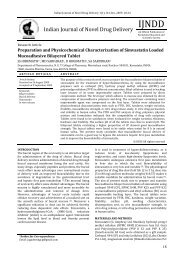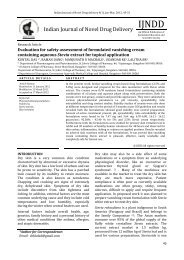Evaluation of Antioxidant Properties of Flower Heads of ...
Evaluation of Antioxidant Properties of Flower Heads of ...
Evaluation of Antioxidant Properties of Flower Heads of ...
You also want an ePaper? Increase the reach of your titles
YUMPU automatically turns print PDFs into web optimized ePapers that Google loves.
Indian Journal <strong>of</strong> Novel Drug delivery 3(2), Apr-Jun, 2011, 118-124<br />
Indian Journal <strong>of</strong> Novel Drug Delivery<br />
IJNDD<br />
An Official Publication <strong>of</strong><br />
Karnataka Education and<br />
Scientific Society<br />
Research Article<br />
<strong>Evaluation</strong> <strong>of</strong> <strong>Antioxidant</strong> <strong>Properties</strong> <strong>of</strong> <strong>Flower</strong> <strong>Heads</strong> <strong>of</strong> Sphaeranthus<br />
indicus Linn<br />
BAFNA ANAND 1* AND MISHRA SHRIHARI 2<br />
1 Rayat Institute <strong>of</strong> Pharmacy, Railmajra, Dist: SBS Nagar- 144533, Punjab, INDIA<br />
2 Department <strong>of</strong> Pharmacy, Faculty <strong>of</strong> Technology and Engineering, M.S.University <strong>of</strong> Baroda, Kalabhavan, Vadodara-390001.<br />
INDIA<br />
A R T I C L E D E T A I L S<br />
A B S T R A C T<br />
Article history:<br />
Received on 09 May 2011<br />
Modified on 23 June 2011<br />
Accepted on 25 June 2011<br />
Keywords:<br />
Sphaeranthus indicus,<br />
DPPH,<br />
Superoxide,<br />
Lipid peroxidation.<br />
Methanol extract (ME) <strong>of</strong> flowerheads Sphaeranthus indicus Linn. and its<br />
chromatographic methanol fraction (CMF) were screened for in-vitro antioxidant<br />
activity subjecting to DPPH free radical scavenging assay, superoxide scavenging<br />
assay, in-vitro lipid peroxidation and determination <strong>of</strong> reducing power. Both ME<br />
and CMF showed potent in-vitro antioxidant activity, whereas, CMF was more<br />
effective as free radical scavenger than ME. HPTLC fingerprint were undertaken for<br />
identification <strong>of</strong> active components. <strong>Flower</strong>-heads <strong>of</strong> Sphaeranthus indicus<br />
demonstrated in-vitro antioxidant activity in present study.<br />
© KESS All rights reserved<br />
INTRODUCTION<br />
Experimental evidence suggests that free<br />
radicals (FR) and reactive oxygen species (ROS)<br />
can be involved in high number <strong>of</strong> diseases [1] . As<br />
plant produce lot <strong>of</strong> chemical moieties as<br />
antioxidants to control oxidative stress caused<br />
by sunbeams and oxygen, these can serve as<br />
source <strong>of</strong> new antioxidant compounds [2].<br />
Ayurveda, an ancient Indian system <strong>of</strong> medicine,<br />
follow in prevention and treatment <strong>of</strong> various<br />
diseases a group <strong>of</strong> large number <strong>of</strong> medicinal<br />
plants which are considered active due to<br />
chemical constituents and are designated as<br />
‘Rasayana’ as one <strong>of</strong> the clinical specialties.<br />
Rasayana is not only a drug therapy but is a<br />
specialized procedure practiced in the form <strong>of</strong><br />
rejuvenating recipes, dietary regimen promoting<br />
good habits. The purpose <strong>of</strong> rasayana is two-fold:<br />
prevention <strong>of</strong> disease and counteracting aging<br />
process, which result from optimization <strong>of</strong><br />
homeostasis [3] . Sharma et al. reported the<br />
strong antioxidant activity shown by rasayana<br />
drugs [4] . Around 34 plants are identified as<br />
Rasayanas in the Ayurvedic system <strong>of</strong> medicine<br />
[5].<br />
*Author for Correspondence:<br />
Email: anandbafna65@gmail.com<br />
These plants are described to possess various<br />
pharmacological properties such as<br />
immunostimulant, tonic, neurostimulant, antiageing,<br />
anti-bacterial, anti-viral, anti-rheumatic,<br />
anti-cancer, adaptogenic, anti-stress etc. Among<br />
these plants enlisted, some have been<br />
specifically investigated for their well<br />
demonstrated antioxidant activity [6] .<br />
Sphaeranthus indicus Linn. (Family-Compositae)<br />
is an herb found mostly in southern India. It is a<br />
bitter stomachic, stimulant, alterative, pectoral<br />
and demulcent, and externally emollient.<br />
Distilled water prepared like rose water from the<br />
herb is recommended by Hakims (Physicians <strong>of</strong><br />
Unani System <strong>of</strong> Medicine) for bilious affections<br />
and for dispersions <strong>of</strong> various kinds <strong>of</strong> tumors.<br />
<strong>Flower</strong>s (flower heads) are highly esteemed as<br />
alternatives, depuratives, refrigerants and tonics,<br />
useful as blood purifiers in skin diseases. The<br />
drug is also useful in urethral discharges and in<br />
jaundice [7] . It is one <strong>of</strong> the Rasayana drugs <strong>of</strong><br />
Ayurveda and the activity is attributed to flower<br />
heads <strong>of</strong> the plant. The objective <strong>of</strong> the present<br />
investigation was therefore set to study the<br />
antioxidant activity <strong>of</strong> flower heads <strong>of</strong> S.indicus<br />
using in-vitro methods.<br />
METHODS<br />
Plant material<br />
Fresh flower heads <strong>of</strong> S.indicus were collected<br />
from the outfield <strong>of</strong> Baroda city, India and<br />
118
Bafna Anand et al / Indian Journal <strong>of</strong> Novel Drug Delivery 3(2), Apr-Jun, 2011, 118-124<br />
authenticated in Botany Department <strong>of</strong><br />
M.S.University, Baroda, India.<br />
Extract preparation and fractionation <strong>of</strong><br />
extracts<br />
Separate maceration <strong>of</strong> air-dried, powdered<br />
flower heads <strong>of</strong> S.indicus afforded methanol<br />
extract (ME) in 6.65% (w/w) yield. M E (40 g)<br />
was fractionated by loading on silica gel (100-<br />
200 mesh) and eluted with petroleum ether<br />
(5.23 g), benzene (5.76 g), chlor<strong>of</strong>orm (1.30 g)<br />
and methanol (CMF) (24.4 g). ME gave positive<br />
tests for alkaloids, phenolic compounds,<br />
phytosterols and terpenoids on phytochemical<br />
screening, whereas CMF retained mainly<br />
phenolic compounds and alkaloids.<br />
TLC finger print pr<strong>of</strong>ile<br />
HPTLC finger print pr<strong>of</strong>ile was established for<br />
both ME and CMF. A stock solution (1mg/ml)<br />
was prepared in methanol. Suitably diluted stock<br />
solution was spotted on pre-coated Silica gel G60<br />
F254 TLC plates using CAMAG Linomat V<br />
Automatic Sample Spotter and the plates were<br />
developed in solvent systems <strong>of</strong> different<br />
polarities to resolve polar and non-polar<br />
components <strong>of</strong> the bioactive fraction. The plates<br />
were scanned using TLC Scanner 3 (CAMAG) at<br />
254 nm (absorbance/reflectance mode) and 366<br />
nm (fluorescence/reflectance mode) and Rf<br />
values, spectra, λ max and peak areas <strong>of</strong> resolved<br />
bands were recorded. Relative percentage area<br />
<strong>of</strong> each <strong>of</strong> bands was calculated from peak areas.<br />
Developed chromatograms in different solvent<br />
systems were then sprayed with<br />
phosphomolybdic acid regent and NP-PEG<br />
reagent to detect phenolic compounds and<br />
flavonoids type <strong>of</strong> compounds respectively.<br />
Figure 1, shows characteristic chromatograms.<br />
In-vitro antioxidant activity<br />
Assay for antiradical activity with DPPH<br />
Antiradical activity was measured by a decrease<br />
in absorbance at 516 nm <strong>of</strong> a methanolic solution<br />
<strong>of</strong> colored 1, 1, diphenyl picryl hydrazine brought<br />
about by sample [8] . A stock solution <strong>of</strong> DPPH was<br />
prepared by dissolving 4.4 mg in 3.3 ml<br />
methanol. Test medium includes 150µl <strong>of</strong> DPPH<br />
solution along with different concentration <strong>of</strong><br />
samples in 3 ml methanol. Blank was performed<br />
in the same way with no sample added. Decrease<br />
in absorbance, in presence <strong>of</strong> sample was noted<br />
after 15 minutes. EC 50 was calculated as 50%<br />
reduction in absorbance brought about by<br />
sample compared with blank.<br />
Assay for superoxide radical scavenging<br />
activity<br />
The assay was based on capacity <strong>of</strong> the sample to<br />
inhibit blue formazon formation by scavenging<br />
the superoxide radicals generated in rib<strong>of</strong>lavinlight-nitro<br />
blue tetrazolium (NBT) system [9] . The<br />
reaction medium contains phosphate buffer (pH<br />
7.6) 2.5 ml, 100µl rib<strong>of</strong>lavin (20µg), 200µl EDTA<br />
(12mM), 100µl NBT (0.1 mg) and different<br />
concentration <strong>of</strong> sample contained in 100µl <strong>of</strong><br />
methanol. The reaction was started by<br />
illuminating the reaction mixture for 5 minutes.<br />
The absorbance was measured at 590 nm. Blank<br />
was performed in the same way with 100µl <strong>of</strong><br />
methanol instead <strong>of</strong> test substance. EC 50 was<br />
calculated as 50% reduction in absorbance<br />
brought about by sample compared with blank.<br />
Determination <strong>of</strong> reducing power<br />
The reducing power <strong>of</strong> ME and CMF was<br />
determined according to the method <strong>of</strong> Oyaizu<br />
[10]. Samples were mixed with 5 ml phosphate<br />
buffer (2M, pH 6.6) and 5 ml potassium<br />
ferricyanide (1%), the mixture was then<br />
incubated at 50 0 C for 20 minutes, 5 ml<br />
trichloroacetic acid (10%) was added an the<br />
mixture was centrifuged at 4000 rev./ min. The<br />
upper 5 ml solution was then mixed with 5 ml<br />
distilled water and 1 ml ferric chloride (0.1%).<br />
The absorbance was measured at 700 nm.<br />
Increased absorbance <strong>of</strong> the reaction mixture<br />
indicated increased reducing power. Ascorbic<br />
acid (0.3 mg) was used as standard.<br />
Measurement <strong>of</strong> effect on lipid peroxidation<br />
on rat liver homogenate<br />
Rat liver homogenate was prepared by<br />
homogenizing the tissue in chilled Tris buffer<br />
(10mM, pH 7.4) at a concentration <strong>of</strong> 10% w/v;<br />
peroxidation was induced in liver tissue by Iron-<br />
ADP complex in the presence <strong>of</strong> ascorbic acid.<br />
The incubation medium constituted 0.5 ml <strong>of</strong> the<br />
liver homogenate (10% w/v), 100 µM FeCl 3, 1.7<br />
µM ADP, 500 µM <strong>of</strong> ascorbate and different<br />
concentrations <strong>of</strong> samples in 2 ml <strong>of</strong> total<br />
incubation medium. The medium was incubated<br />
for 20 min. at 37 0 C. Extent <strong>of</strong> lipid peroxidation<br />
was measured by estimation <strong>of</strong> malondialdehyde<br />
(MDA) content [11] . Results were expressed in<br />
terms <strong>of</strong> decrease in MDA formation by the<br />
sample extract. Ascorbic acid was used as<br />
positive control.<br />
119
Bafna Anand et al / Indian Journal <strong>of</strong> Novel Drug Delivery 3(2), Apr-Jun, 2011, 118-124<br />
RESULTS AND DISCUSSION<br />
The participation <strong>of</strong> reactive oxygen species in<br />
etiology and physiopathology <strong>of</strong> human disease,<br />
such as neurodegenerative disorders,<br />
inflammation, viral infection, autoimmune<br />
pathologies and digestive system disorders such<br />
as gastrointestinal inflammation and gastric<br />
ulcers is already evident. The understand role <strong>of</strong><br />
these reactive oxygen species in several<br />
disorders and potential antioxidant protective<br />
effect <strong>of</strong> natural compounds on affected tissues<br />
are topics <strong>of</strong> high current interest. Initially it is<br />
necessary to investigate in-vitro antioxidant<br />
properties <strong>of</strong> any natural product or drug to<br />
consider it as an antioxidant substance, followed<br />
by evaluation <strong>of</strong> its antioxidant function in<br />
biological systems [12] .<br />
In the present attempt therefore antioxidant<br />
activity <strong>of</strong> the ME and CMF <strong>of</strong> flower-heads <strong>of</strong><br />
S.indicus was first evaluated in-vitro and the<br />
chemical composition <strong>of</strong> CMF being more active,<br />
was undertaken by establishing its TLC<br />
fingerprint pr<strong>of</strong>ile.<br />
In-vitro antioxidant activity<br />
DPPH is a stable free radical in aqueous or<br />
ethanol solution and accepts an electron or<br />
hydrogen radical to become a stable diamagnetic<br />
molecule [13] . In order to evaluate antioxidant<br />
potency through free radical scavenging with the<br />
test samples, the change in the optical density <strong>of</strong><br />
DPPH radicals is monitored. Hence, DPPH· is<br />
usually used as a substrate to evaluate<br />
antioxidative activity <strong>of</strong> antioxidants [14] . ME and<br />
CMF showed a concentration dependent<br />
antiradical activity by inhibiting DPPH radical<br />
with an EC 50 value <strong>of</strong> 806.26 μg/ml and 258.43<br />
μg/ml respectively (Table 1). CMF showed<br />
almost three times more inhibitory activity on<br />
DPPH stable radical than ME. Standard curcumin<br />
showed EC 50 at 52.71 μg/ml. CMF was found<br />
less potent than standard curcumin.<br />
Superoxide radical is known to be very harmful<br />
to cellular components as precursor <strong>of</strong> more<br />
reactive oxygen species [15] . ME and CMF were<br />
found as scavenger <strong>of</strong> superoxide radical<br />
generated in rib<strong>of</strong>lavin-NBT-light system in-vitro.<br />
EC 50 values <strong>of</strong> ME and CMF were found 687.56<br />
and 107.92 μg/ml respectively. CMF was six<br />
times more potent than ME but was lesser than<br />
ascorbic acid. EC 50 <strong>of</strong> ascorbic acid was 23.52<br />
μg/ml (Table 2).<br />
Table 1: Antiradical activity <strong>of</strong> ME and CMF <strong>of</strong><br />
S.indicus flowerheads observed with DPPH<br />
Samples<br />
Concentration<br />
(μg/ml)<br />
% inhibition EC 50<br />
ME 250 17.81± 1.36<br />
500 27.68 ± 1.82<br />
750 34.07 ± 0.81<br />
1000 71.70 ± 1.69<br />
(μg/ml)<br />
806.26<br />
CMF 100 25.67 ± 0.20 258.43<br />
200 42.18 ± 1.43<br />
300 54.21 ± 1.49<br />
400 72.77 ± 1.40<br />
Curcumin 52.71<br />
Values are mean ± S.E.M. <strong>of</strong> three replicate analyses.<br />
Table 2: Superoxide anion scavenging activity <strong>of</strong> ME<br />
and CMF <strong>of</strong> S.indicus flowerheads observed with a<br />
rib<strong>of</strong>lavin-light-NBT system<br />
Samples<br />
Concentration<br />
(μg/ml)<br />
% inhibition EC 50<br />
(μg/ml)<br />
ME 250 27.76 ± 1.48 687.56<br />
500 39.45 ± 2.09<br />
750 49.96 ± 1.64<br />
1000 69.30 ± 3.76<br />
CMF 50 30.14 ± 3.16 107.92<br />
Ascorbic<br />
acid<br />
100 51.20 ± 1.84<br />
150 62.73 ± 1.70<br />
200 76.51 ± 2.22<br />
Values are mean ± S.E.M. <strong>of</strong> three replicate analyses<br />
23.52<br />
Table 4: Inhibition <strong>of</strong> lipid peroxidation induced by<br />
iron/ADP/ascorbate system in rat liver homogenate<br />
by ME and CMF <strong>of</strong> S.indicus flowerheads<br />
Samples<br />
Concentration<br />
(μg/ml)<br />
% inhibition EC 50<br />
(μg/ml)<br />
ME 200 18.65 ± 0.98 528.03<br />
400 39.25 ± 1.26<br />
600 65.00 ± 2.22<br />
800 75.58 ± 0.99<br />
1000 80.25 ± 2.56<br />
CMF 100 23.74 ± 0.87 290.62<br />
Ascorbic<br />
acid<br />
200 40.37 ± 0.91<br />
300 52.15 ± 2.43<br />
400 66.23 ± 3.05<br />
500 73.35 ± 1.29<br />
30.05<br />
Values are mean ± S.E.M. <strong>of</strong> three replicate analyses.<br />
120
Bafna Anand et al / Indian Journal <strong>of</strong> Novel Drug Delivery 3(2), Apr-Jun, 2011, 118-124<br />
Table 3: Reducing power determination <strong>of</strong> different concentrations <strong>of</strong> ME and CMF <strong>of</strong> S.indicus<br />
Sample<br />
Reducing powers <strong>of</strong> different concentrations (mg/ml)<br />
0.0 5.0 10.0 15.0<br />
ME 0.028 ± 0.01 0.100 ± 0.07 0.220 ± 0.12 0.313 ± 0.10<br />
CMF 0.028 ± 0.01 0.120 ± 0.09 0.250 ± 0.16 0.353 ± 0.20<br />
Values are mean ± S.E.M. <strong>of</strong> three replicate analyses.<br />
Ascorbic acid (0.3 mg) was used as standard, giving a reading <strong>of</strong> 0.430 at 700 nm.<br />
Table5: TLC finger printing pr<strong>of</strong>ile <strong>of</strong> bioactive fraction <strong>of</strong> S.indicus<br />
Scanned at Solvent system 1 Solvent system 2 Solvent system 3<br />
Rf λmax Relative<br />
%<br />
Rf λmax Relative<br />
%<br />
Rf λmax Relative<br />
254 nm 0.10 319 3.68 0.32 330 64.30 0.23 200 0.98<br />
0.19 348 1.71 0.45 203 5.31 0.31 323 2.60<br />
0.24 312 5.90 0.75 200 30.39 0.44 318 8.13<br />
0.35 607 3.19 0.49 324 1.24<br />
0.69 580 0.74 0.60 328 12.31<br />
0.81 233 9.68 0.81 228 47.09<br />
0.90 332 75.10 0.91 327 27.63<br />
366 nm 0.07 323 8.54 0.09 328 4.87 0.11 324 3.60<br />
0.11 313 5.96 0.36 329 92.34 0.14 323 1.90<br />
0.15 335 7.45 0.42 203 3.79 0.35 324 6.90<br />
0.23 309 23.36 0.38 317 1.21<br />
0.38 580 30.32 0.49 327 2.17<br />
0.49 613 24.37 0.56 327 11.11<br />
0.56 223 7.41 0.72 329 54.14<br />
0.90 332 20.15 0.78 200 4.35<br />
%<br />
0.89 296 13.59<br />
0.95 228 1.03<br />
Solvent system 1. Toluene/Ethyl acetate (7:3 v/v); Solvent system 2. Ethyl acetate/Methanol/Water (10:1.35:1.00 v/v);<br />
Solvent system 3. n-butanol/glacial acetic acid/water (6:2:2 v/v).<br />
The measurement <strong>of</strong> reductive ability was done<br />
by Fe3+-Fe2+ transformation in the presence <strong>of</strong><br />
samples ME, CMF and standard antioxidant,<br />
ascorbic acid [10]. The reducing power is<br />
associated with antioxidant activity [14] . As<br />
shown in Table 3, ME and CMF had similar<br />
reductive capabilities as these showed reducing<br />
power comparable with standards at higher<br />
concentration i.e. at 15 mg/ml.<br />
Lipid peroxidation is initiated by radicals<br />
attacking unsaturated fatty acids, and<br />
propagated by a chain reaction cycle [16] . Since<br />
unsaturated fatty acids are most important<br />
components <strong>of</strong> biological membranes and impart<br />
desirable properties upon the fluidity <strong>of</strong> cellular<br />
membrane structure, the peroxidation <strong>of</strong><br />
unsaturated fatty acids in biological membranes<br />
leads to disruption <strong>of</strong> membrane structure and<br />
function [17] . In particular O - 2 and . OH induce<br />
various injuries to the surrounding organs and<br />
play a vital role in some clinical disorders.<br />
Therefore removal <strong>of</strong> O - 2 and . OH is the most<br />
effective defense <strong>of</strong> the living body against<br />
disease [18] . Any compound – natural or synthetic<br />
– with antioxidant properties might totally or<br />
partially alleviate this damage. In the present<br />
study ME and CMF showed potent inhibition <strong>of</strong><br />
lipid peroxidation induced by<br />
Iron/ADP/Ascorbate complex in rat liver<br />
homogenate. EC 50 values for ME and CMF were<br />
528.03 and 290.62 μg/ml respectively. Both test<br />
samples showed dose dependent inhibition <strong>of</strong><br />
lipid peroxidation. Standard ascorbic acid<br />
showed EC 50 value 30.05 μg/ml (Table 4).<br />
121
Bafna Anand et al / Indian Journal <strong>of</strong> Novel Drug Delivery 3(2), Apr-Jun, 2011, 118-124<br />
A<br />
Wavelength - 254 Wavelength - 366<br />
B<br />
C<br />
Figure 1: TLC chromatogram <strong>of</strong> bioactive fraction <strong>of</strong> S.indicus run in three different solvent system<br />
and scanned at 254 and 366 nm (solvent systems as in Table 3) A- Solvent system 1, B- Solvent system<br />
2, C- Solvent system 3.<br />
Recent studies showed that a number <strong>of</strong> plants<br />
products include polyphenolic substances such<br />
as flavonoids and tannins. Those natural<br />
antioxidative substances usually have a phenolic<br />
moiety in their molecular structure. They have<br />
been found among flavonoids, tocopherols and<br />
catechines. Organic acids, carotenoids, protein<br />
hydrolysates and tannins can act as antioxidants<br />
or have synergistic effects when used together<br />
with phenolic antioxidants. Phenolic antioxidants<br />
are potent free radical terminators [19] . Phenolic<br />
compounds, biologically active components, are<br />
the main agents that can donate hydrogen to free<br />
radicals and thus break the chain reaction <strong>of</strong> lipid<br />
oxidation at the first initiation step. This high<br />
potential <strong>of</strong> phenolic compounds to scavenge<br />
radicals may be explained by their phenolic<br />
hydroxyl groups [20] . In present study both the<br />
samples revealed the presence <strong>of</strong> phenolic<br />
compounds and flavonoids and one can therefore<br />
substantiate their activity pertaining to the<br />
chemical composition. Table 5 explains the<br />
chromatographic details <strong>of</strong> CMF which can be<br />
utilized further to assess the quality <strong>of</strong> it.<br />
122
Bafna Anand et al / Indian Journal <strong>of</strong> Novel Drug Delivery 3(2), Apr-Jun, 2011, 118-124<br />
It was observed during present evaluation <strong>of</strong><br />
antioxidant activity that CMF had 5-6 times more<br />
scavenging activity than ME. Results <strong>of</strong><br />
preliminary phytochemical work indicated that<br />
CMF constituted 61% <strong>of</strong> ME, rest were non polar<br />
components extracted with petroleum ether,<br />
benzene and chlor<strong>of</strong>orm. All these fractions <strong>of</strong><br />
ME were ineffective in scavenging free radicals<br />
(results not included). Therefore, it can be<br />
considered that free radical scavenging activity<br />
<strong>of</strong> ME was due to CMF only. Phytochemical<br />
reports on S.indicus flowerheads revealed<br />
presence <strong>of</strong> alkaloids [21] , eudesmanolides and<br />
sesquiterpenoids [22, 23] . The exact mechanism <strong>of</strong><br />
action, however, could only be unfolded after<br />
detailed characterization <strong>of</strong> active moieties from<br />
different fractions. Studies on these lines have<br />
already been taken up and shall follow in our<br />
future communications.<br />
CONCLUSIONS<br />
The results <strong>of</strong> present study indicate that<br />
flowerheads <strong>of</strong> S.indicus carry certain levels <strong>of</strong><br />
antioxidant activities. ME and CMF both were<br />
effective in scavenging stable free radical DPPH,<br />
superoxide ion and possess good reducing power<br />
with inhibitory action on lipid peroxidation. The<br />
activity was however <strong>of</strong> moderate nature when<br />
compared to different standard antioxidants.<br />
Further in-vivo studies on evaluation <strong>of</strong> drug are<br />
warranted and already taken up .It may be<br />
concluded that the free radical scavenging<br />
activity <strong>of</strong> flower-heads <strong>of</strong> S.indicus may follow<br />
one <strong>of</strong> the above mechanisms in exhibiting its<br />
effectiveness in traditional medicine.<br />
REFERENCES<br />
[1] Richards RT, Sharma HM. Free radicals in<br />
health and disease. Ind J Clin Pract. 1991; 2<br />
(7): 15-26.<br />
[2] Glaser J L. Maharishi Ayurveda: An<br />
introduction to recent research. Mod Sci<br />
and Ved Sci. 1988; 2(1), 89-108.<br />
[3] Singh RH. Rasayana and Vajikarana In:<br />
Sharma PV, ed. History <strong>of</strong> Medicine in India.<br />
Indian National Science Academy. New<br />
Delhi, 1992.<br />
[4] Sharma HM, Hanna AN, Kauffman EM,<br />
Newman HAI. Inhibition <strong>of</strong> human low<br />
density lipo-protein oxidation in vitro by<br />
Maharishi Ayurveda herbal mixtures.<br />
Pharmacol Biochem and Behav. 1992; 43:<br />
1175-1182.<br />
[5] Sharma PV. Translation: Charka Samhita,<br />
Chikitsothana. 1 st edition, Varanasi<br />
Chaukhambha Orientalia, 1981. P.<br />
[6] Scartezzini P, Speroni E. Review on some<br />
plants <strong>of</strong> Indian traditional medicine with<br />
antioxidant activity. J Ethnopharmacol.<br />
2000; 71: 23-43<br />
[7] Nadkarni KM. Indian Materia Medica, 3 rd<br />
edition, Popular Prakashan, 1976. Vol.3, p<br />
1163.<br />
[8] Vani T, Rajani M, Sarkar S, Shishoo CJ.<br />
<strong>Antioxidant</strong> properties <strong>of</strong> the Ayurvedic<br />
formulation Triphala and its constituents.<br />
Int J Pharmacog. 1997; 35(5): 313-317<br />
[9] Beuchamp C, Fridovich I. Superoxide<br />
dismutase: Improved assays and assay<br />
applicable to acrylamide gels. Anal<br />
Biochem. 1971; 44: 276-277.<br />
[10] Oyaizu M. Studies on product <strong>of</strong> browning<br />
reaction prepared from glucose amine. Jpn<br />
J Nutr. 1986; 44: 307-315<br />
[11] Slater TF, Sawyer BC. The stimulatory<br />
effects <strong>of</strong> carbon tetrachloride and other<br />
halosenoalkanes on peroxidative reactions<br />
in rat liver fractions in vitro. Bin-Item. J.<br />
1971; 123:805-814.<br />
[12] Repetto MG, Llesuy SF. <strong>Antioxidant</strong><br />
properties <strong>of</strong> natural compounds used in<br />
popular medicine for gastric ulcer. Braz J<br />
Med Biol Res. 2002; 35(5): 523-534.<br />
[13] Soares JR, Dinis TCP, Cunha, A P, Ameida,<br />
LM. <strong>Antioxidant</strong> activity <strong>of</strong> some extracts <strong>of</strong><br />
Thymus zygis. Free Rad. Res. 1997; 26:<br />
469-478.<br />
[14] Duh PD, Tu YY, Yen GC. <strong>Antioxidant</strong> activity<br />
<strong>of</strong> water extract <strong>of</strong> harng jyur (<br />
Chrysanthemum morifolium Ramat).<br />
Lebensm.-Wiss.u-Technol. 1999; 32: 269-<br />
277.<br />
[15] Halliwell B, Gutteridge JMC. In: Free<br />
radicals, ageing and disease. Free radicals<br />
in Biology and Medicine, 2 nd edition,<br />
Oxford, Clarendron press, 1985. P. 279-<br />
315.<br />
[16] Shimazaki H. <strong>Antioxidant</strong>s. In: Free radicals<br />
and biological defense, Niki E, Shimazaki, H,<br />
Mino, M (eds), Japanese Science Societies<br />
Press. Tokyo. 1994. p. 45-57.<br />
[17] Machlin LJ, Bendich A. Free radical tissue<br />
damage: Protective role <strong>of</strong> antioxidant<br />
nutrients. FASEB J. 1987; 1: 441-445.<br />
[18] Lin JM, Lin CC, Chen MF. Scavenging effects<br />
<strong>of</strong> Mallotus repandus on active oxygen<br />
species. J Ethnopharmacol. 1995; 46:175-<br />
181<br />
123
Bafna Anand et al / Indian Journal <strong>of</strong> Novel Drug Delivery 3(2), Apr-Jun, 2011, 118-124<br />
[19] Shahidi F, Wanasundara PKJPD. Phenolic<br />
antioxidants. Crit Rev Food Sci Nutrit.<br />
1992; 32: 67-103.<br />
[20] Sawa T, Nakao M, Akaike T, Ono K, Maeda<br />
H. Alkylperoxyl radical scavenging activity<br />
<strong>of</strong> various flavonoids and other phenolic<br />
compounds: Implications for the<br />
antitumor promoter effect <strong>of</strong> vegetables. J<br />
Agric Food Chem. 1999; 47: 397- 492<br />
[21] Chughtai MID, Khokhar I, Ahmad A.<br />
Isolation, purification and structural<br />
determination <strong>of</strong> alkaloids from the flowers<br />
<strong>of</strong> Sphaeranthus indicus. Sci Int. (Lahore).<br />
1992; 4(2): 151-154<br />
[22] Rojatkar SR, Nagsampagi BA. 7-<br />
hydroxylated eudesmanolides from<br />
Sphaeranthus indicus Linn. Phytochem.<br />
1992; 31 (9): 3270-3271<br />
[23] Gogte MG, Ananthasubramanian L,<br />
Nargund KS, Bhattacharya SC. Some<br />
interesting sesquiterpenoids from<br />
Sphaeranthus indicus Linn. Ind J Chem.<br />
1986; 25(B): 233-238<br />
124


